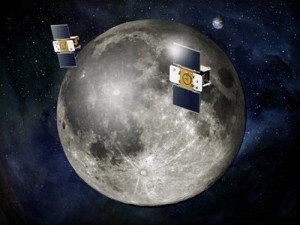Two robotic probes from NASA began orbiting moon to map lunar interior
Wednesday, January 4th, 2012 10:05:58 by Zeeshan Gohar
Two robotic probes from NASA began orbiting moon to map lunar interior
NASA-sent two robotic probes have started orbiting the moon to map the lunar interior. NASA sent its twin Gravity Recovery and Interior Laboratory (GRAIL) spacecraft, which wrapped up
2.6-million-mile journey, on December 31 and January 1 to put them into lunar orbit.
The probes will take two months to adjust the 34-mile-high orbits to get into optimal position so that they can measure the pushes and pulls of the gravity of moon. The scientists will
use that data to find out what is inside the moon.
NASA wrote on its Twitter feed after the first GRAIL spacecraft finished a 40-minute braking manoeuvre on New Year’s Eve, “Pop the bubbly and toast the moon.”
The second spacecraft was launched after 25 hours. Both probes will start working accordingly to map the intricate gravity in March.
NASA updated their twitter feed after the ground control teams received radio signals on Sunday, which confirmed the arrival of second spacecraft, “Everything is looking good. It’s going
to be a great 2012.”
Within the next two months, the orbits of probes will be tweaked until they start flying in a formation, low over the lunar poles. The spacecrafts will speed up slightly in response to
the extra gravitational tugs, as they fly over denser regions of the moon.
The scientist can generate a gravity map of the moon by constantly measuring changes in the distance between the two craft. The changes in speed will be measured as a fraction of a micron
per second. A micron is about the width of a red blood cell.
Scientists believe that the moon was formed after the Earth was smashed by an object about the size of Mars, shortly after the formation of the solar system about 4.5 billion years ago.
However, the question of how the moon evolved remains unanswered.
This new NASA mission will take at least 82 days to wrap up. The probes sent by NASA are solar-powered, built by Lockheed Martin Corp, and might survive beyond the next lunar eclipse in
June. The $496 million mission might be extended for a more detailed mapping survey after the eclipse.
Short URL: https://www.newspakistan.pk/?p=8131

















